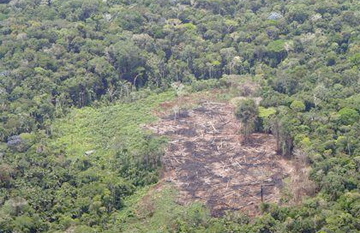Changes in rainfall resulting from climate change may drive the parts of Amazon rainforest toward seasonal forests rather than savanna, argue researchers writing in the Proceedings of the National Academy of Sciences
Comparing climate simulations by 19 global climate models with observations from the 20th century, Yadvinder Malhi and colleagues found that most projections underestimate rainfall, suggesting the Eastern Amazon will still have enough precipitation to support seasonal forest, rather than savanna. The conclusion contrast to the “dieback” theory — which holds that the southern and eastern Amazon would transition towards savanna with warming — advanced by other researchers.
 Deforestation, fire, and forest in the Peruvian Amazon |
“The rainfall regime of E. Amazonia is likely to shift over the 21st century in a direction that favors more seasonal forests rather than savanna,” write the authors. “Under mid-high-range emissions scenarios, there is a high probability of intensified dry seasons in
E. Amazonia and a medium probability that the rainfall regime will shift sufficiently to a climate state where seasonal forest is more viable than rainforest.”
However, the authors caution that a die-back is still a “distinct possibility” due to increasing deforestation, forest degradation through logging, and fragmentation, which desiccate forests and increase their risk to fire.
“These seasonal forests may be resilient to seasonal drought but are likely to face intensified water stress caused by higher temperatures and to be vulnerable to fires, which are at present naturally rare in much of Amazonia,” they write. “The spread of fire ignition associated with advancing deforestation, logging, and fragmentation may act as nucleation points that trigger the transition of these seasonal forests into fire-dominated, low biomass forests.”
The authors say that reducing human pressures on the Amazon could increase its resilience to climate change.
“Deliberate limitation of deforestation and fire may be an effective intervention to maintain Amazonian forest resilience in the face of imposed 21st-century climate change. This may be enough to navigate Eastern Amazonia away from a possible ‘tipping point,’ beyond which extensive rainforest would become unsustainable.”
CITATION: Malhi, Y. el al. Exploring the likelihood and mechanism of a climate-change-induced dieback of the Amazon rainforest. PNAS for the week of Feb 9, 2009.